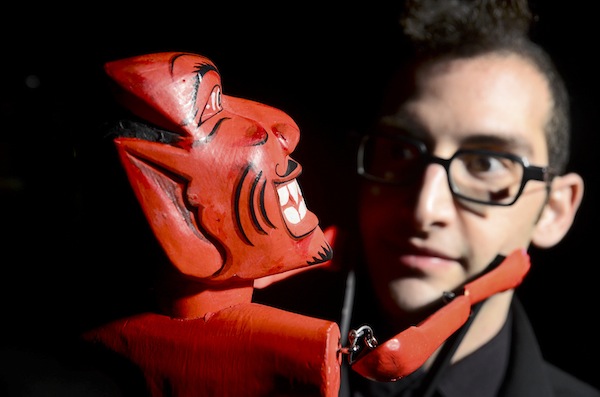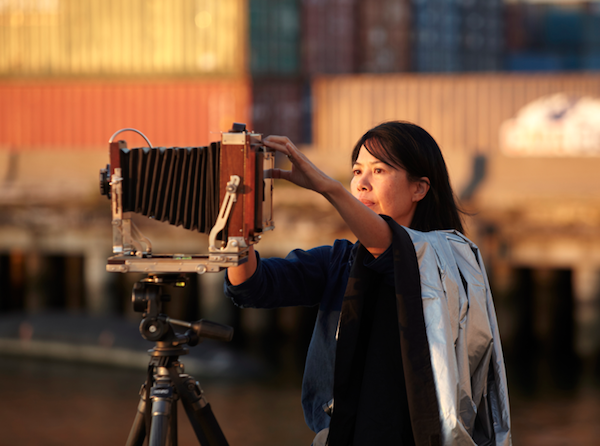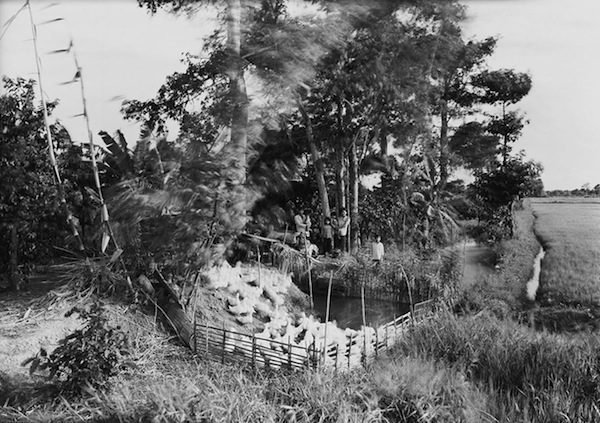In the BMA’s Contemporary Wing, An-My Lê’s photographs stand out as windows against the permanent collection of prominent 2D surfaces and sculptures. Her solo exhibit will be on display at the BMA Front Room Gallery until February 23rd 2014, next door to Gerard Byrne’s photographic work on the Loch Ness monster. The twenty-one pieces in this show are selected from four of Lê’s series: “Vietnam” (1994-98, black & white), “Small Wars” (1999-2002, black & white), “29 Palms” (2003-04, black and white), and “Events Ashore” (2005-present, color).
An-My Lê travels to different parts of the globe to express unspoken effects of the Vietnam war, and to photograph noncombatant U.S. military operations with insightful open-mindedness. Her family lived in war-ravaged Saigon and shortly in Paris before they came to America as refugees in 1975. Since then, she has built an artistic practice from her ambivalent fascination with the American military and it’s effects on the world.
The wall text in the “Events Ashore” room points out that Lê specifically avoids the military imagery typically mythologized in American media and culture. Her photographs of enlisted non-combatants, training zones, peacekeeping patrols, scientific expeditions, and humanitarian missions do not simply portray the military as war’s attendant-in-waiting, but as a variety performer.
Prior to working with the armed forces, Lê’s photographed “Small Wars,” a series which presents the activities of weekend Vietnam war reenactors in America. They allowed her to photograph their hobby on the condition that she participate as a Vietnamese actor in the play.
An-My Lê approaches the military and military culture as a landscape photographer. She uses the camera to make uncomfortable, politicized situations beautiful and more difficult to judge, capturing spontaneous moments on deliberately framed scenic stages. The U.S. military’s polarizing role in world power dynamics earns it extreme critics and supporters, but Lê stays out of politics by avoiding politicizing close ups of dramatic or iconic tension and cliché soldier moments. Her detached perspective seems objective, yet sensitive to complex human situations on various levels of political and cultural appreciation; she catches intersections of reality and poetry from a distance. Her style of photographing is embedded in the cumbersome large format camera she uses, which allows her to slow down the viewing process and create airy, wide open images with a decisive composition. This type of camera helps to define her broad perspective, in contrast to the more targeted search for subject and meaning which characterizes most photography.
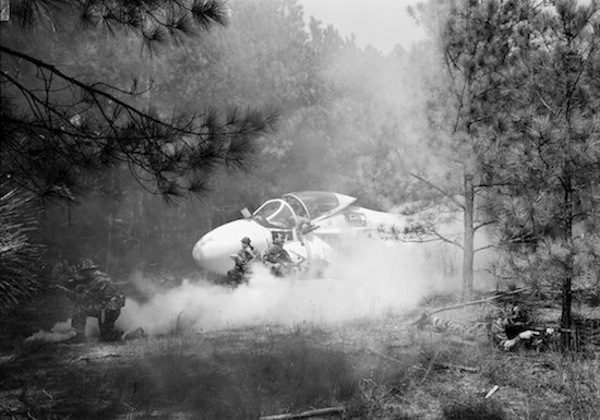 Small Wars (rescue) (1999–2002)
Small Wars (rescue) (1999–2002)
Lê’s works are not simply photographs of the military; these breathtaking views invoke the overwhelming interconnectedness of global systems and ecology, directly and indirectly altered by the global military entity. Her nonchalant subjects complicate one another and reveal big issues – the fragile California desert ecosystem is thumped with artillery rehearsing for the hills of Afghanistan, local children filter among a group of soldiers sitting mundanely on a row of parked humvees on a Haitian beach, and model fighter planes posed on poles over the jungle are loaded with the history of napalm in Vietnam.
At first, some of the images appear to be setups, but no one, besides a few direct portrait subjects, posed for the photos. In “Target Practice, USS Peleliu,” five burly naval members adjust five shooting targets on the edge of a the ship’s deck. Their anonymous uniformed bodies almost appear to take the place of the human silhouettes on the targets, putting the men themselves in the proverbial line of fire. According to Lê in her artist’s talk at MICA, they were practicing to pass time from the monotonous day-to-day, and she planned the composition waiting for them to walk to the targets.
 Target Practice, USS Peleliu, 2005
Target Practice, USS Peleliu, 2005
In most of the photos, massive scenery lies beyond the foreground, stretching to the horizon. The land/seascapes are huge, but the military presence subverts the size of the terrain beneath the reach and power of the military itself. No photograph conveys this tension more elegantly than “Sea Knight Helicopter,” in which the small incoming aircraft appears to balance lightly on the flat horizon of the empty Pacific. It hangs so vulnerably against the infinite blue, yet alludes to so much weight. It’s easy to visualize the helicopter’s flight path to or from the small landing pad protruding into the corner of the photo, evidence of the huge ship beneath Lê’s tripod (the landing pad is cropped from the Google-sourced jpeg below). I simultaneously see that the military is only a drop in the ocean and, absurdly, feel it’s imminent significance to our world.
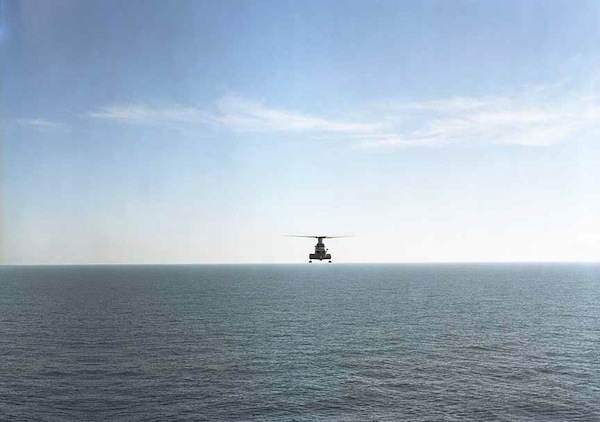 Sea Knight Helicopter, USS Peleliu, California, 2006
Sea Knight Helicopter, USS Peleliu, California, 2006
All of the photographs express Lê’s search to reconcile her own complicated perspective on war and her own life, some without depicting any outright evidence of the military. My favorite print in the selection is “Untitled, Mekong Delta, 1994,” in which a Vietnamese family stands motionless between a wind-blown grove of trees and a fenced-in duck pond, beside a paddy receding into the distance. The rural scene shows no postwar sign of violation, but the huddle of agitated trees and jostling birds appears to close in on the staring figures in a wary enclave, with a creeping sense of anxiety.
I might judge the subjects in “Small Wars” for theatrically recreating a war which no one wants to relive, but I think it’s a history which everyone tries to understand. We continue to make sense of the conflict’s causes and impact upon everything in our world; we even reenact vicariously, through war films (and irreverently, video games) whose creators we trust to immerse us in the gripping horror and humanity. According to Lê in her talk, both she and the hobbyists are trying to do something similar, and many desire to access the experiences of their fathers and relatives. Even these charged photos don’t weigh into political discussion, pulling back from bemusing moments like a unit’s escape from a downed plane in a hostile jungle (not a jungle at all, but a temperate evergreen grove). Like the desert at 29 Palms, the forest is used as a naive approximation of enemy territory, transporting the men trying to reenact the reality of war.
This An-My Lê exhibit is a must-see; the rich, fine details of each large print are a pleasure to explore, and vital to the depth of the work. When I saw the show a few weeks ago, I heard a silver-haired, cursory viewer joke curtly of the “Small Wars” reenactors: “Well I can tell ya who they’re voting for.” Don’t be that viewer… Spend some time with them, think about the world, and second-guess your assumptions about what’s really going on in the photos.
 Beach Landing Site, Haiti, 2010
Beach Landing Site, Haiti, 2010
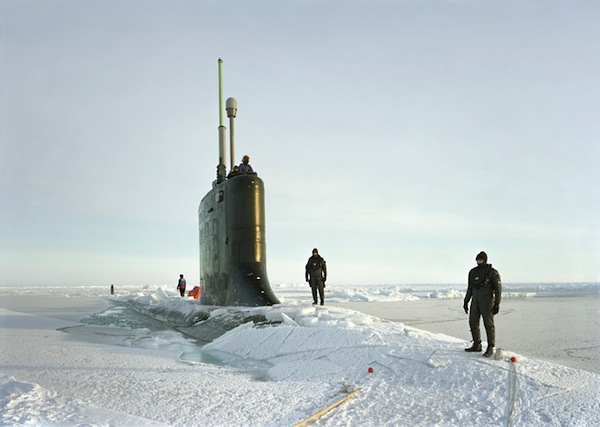 Ice Operations, Arctic Waters, USS New Hampshire, 2011
Ice Operations, Arctic Waters, USS New Hampshire, 2011
Read more on An-My Lê’s work in her Bmoreart interview with Cara Ober and BMA curator Ann Shafer.
* Author Mac Falby studies photography and humanities at the Maryland Institute College of Art, and will graduate in Spring, 2014.

